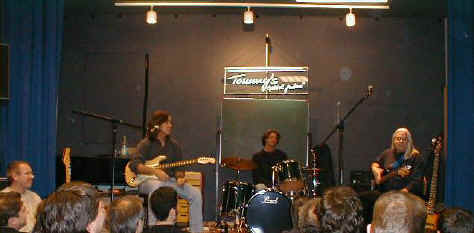| Guitar Monster and session great Carl Verheyen, along with bassist Cliff Hugo and drummer Steve (didn't catch the last name!), held a great clinic at the Musikschule in Viersen, Germany on February 5, 2001. Located at 82 Gereonstraße, the school has a small auditorium for the standing room only clinic. | |
|
Carl played a Tommy’s Special
swamp-ash strat-style guitar through a Hot-Rod Fender Twin. He was using his standard
pedal board – I apologize for the upside down photo below but you get the picture.
His bassist was using a Music Man 5-string Stingray and a Tommy’s Special
semi-hollowbody 4-string bass. Great sound. Note -- the guy with the light colored shirt in the extreme left of the photo is Tommy of Tommy's Guitars.
|
 |
| This photo of Carl's board shows a pretty compact layout, and not a lot of exotic effects. It sounded awesome, and his wah technique was just great. |
|
| The following are notes from the clinic, and they are rambling because Carl’s subject matter jumped around a great deal during the clinic. | |
|
Starting at 7:30 PM, Carl started with some "war stories" about his early days of playing. One of the good ones was when Carl loaned Mr. Eddie Van Halen a Les Paul, and VH dropped it. Carl was horrified, as I would be. I think this shows Eddie’s workmanlike attitude toward guitars. Like me, he stated that seeing Steve Morse and the Dixie Dregs changed his outlook on guitar. Carl was a hardcore jazz guy until he saw the Dregs. Steve Morse’s versatility was humbling, and I couldn’t agree more. Carl described his personal style as a "melting pot." His biggest lesson is to be versatile because the music business is a big pie. If you play country only, that is a piece of the pie. If you are a metal guy, that is a piece of the pie. If you want to make it in the studio business, you have to be conversant in as many styles as possible – grab as much of the pie as you can. Carl has 46 guitars, and has about 24 delivered for each session by his cartage company. He actually mentioned that he does use a POD in addition to many, many amps. In answer to a question about reading music, Carl stated that reading music is critical because confidence is so important during sessions. He said only about 30% of the sessions he does have notation that must be read. However, once the word gets out in the studio community that you don’t read you won’t get many sessions. His technique for improving his reading was getting a partner and sight-reading pieces everyday. He would play several hours daily, and he stated the improvement was dramatic and quick. His favorite duets were by Bach (not the guy in Skid Row). He learned during the duet period that you have to read in the position of the key. This allows you to play in an easy position. Because a lot of the music was written for the piano, it takes a little analysis to figure out where to play it on the guitar. For example, rather than starting on the root C on the A string, third position, start on the C on the E String, eighth position. He played several examples, and he made it look really easy. He also stated that reading music is more about getting the rhythms correct. There are only so many ways to play an eighth note, and he showed the audience the different rhythms you’d see in 4/4 time. A very interesting perspective. He recommended that guitarists keep a "music notebook" to write down ideas in. This was a similar theme to his clinic in July 00. Taping is not very practical, and he spoke a great deal about this. After the reading section, he and the band played a killer version of the country classic "Six Days on the Road". He did some awesome "chicken pickin" with some impossibly wide intervals. He made the Strat sound so Tele-like! Practice. He likes to pick a particular key and just jam. He said he would play for hours in just one key to explore it. He also said he likes to play lines and alter them by changing the 3rd and the 7th. He played some examples – a great way to get some spice back into those scales. |
|

